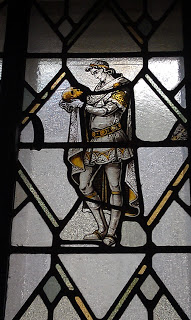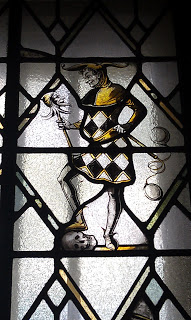[ These have apparently gotten out of order, darn it. This obviously should have come out before the Foolish Games post! -d ]
So after taking the appropriate amount of pictures outside, in we went.
Straight ahead is a theatre (empty, there is no show right now). I spy a guest book! I write Duane “Shakespeare Geek” Morin in it. Ha!
My wife, with the kids, wanders into the theatre. The security guard wanders in right behind them. He’s not scooting them out, however – he’s encouraging them to go down and take pictures, just not to get on the stage. We did get pictures, but since they all have my kids in them I can’t post them here.
He asks if we’re big fans of Shakespeare. I tell him that we’re here by invitation of Garland Scott (Director of External Relations) to tour the vault, he tells me how lucky I am. I agree. (For the record I did not say it like that, I just wrote it like that for link purposes – I said “We’re here to see Garland.”)
He shows us the gift shop, where we’re supposed to meet at 2pm. It’s early, so we wander around for a little while, looking for stuff to buy (or, rather, stuff to not buy as I am starting with the assumption that I’ll take one of everything, and then put stuff back one thing at a time :)).
Georgianna Ziegler, Head of Reference, wanders over, spies my shirt, and says “You must be my two o’clock!” Indeed I am. Introductions are made all around, and I sign in with security. Again, I write “ShakespeareGeek.com” as my Company. For posterity, don’t ya know.
At this point Garland was not with us, so Georgianna begins the tour solo but has to call for a backup. I learn later that this is one of the rules, for security.
We learn about Mr. and Mrs. Folger. I had no idea that Mr. Folger died before the library was complete, so he never got to see it. This has led to plenty of ghost stories about Folger walking the stacks, and Georgianna shares her own story of the ghost elevator opening itself at will. This fascinates my boy, who spends the rest of the tour asking whether we too would be going on the ghost elevator. I can’t tell if he’s excited about this or terrified.
I would have taken about a million more pictures, but this was a library after all and we were trying to be particularly quiet – which meant about 110% of my attention spent on praying that my boy didn’t get me kicked out. Luckily Georgianna let us continue, and I let the little geeklet live.
Shortly Garland joined us, and it was down into the vaults! I most definitely did get pictures down there (after asking permission), so stay tuned for a whole series of what I got to see!
My trip continues …
This posting marathon, in celebration of Shakespeare Day, is brought to you by nothing but my time, my resources, and my love for the subject. While we’ll always be the original Shakespeare blog, it takes a significant amount of effort to make us the best in the digital universe. If you’ve not yet seen how you can show your support, now’s a great opportunity. If you’ve already done so, thanks very much!



